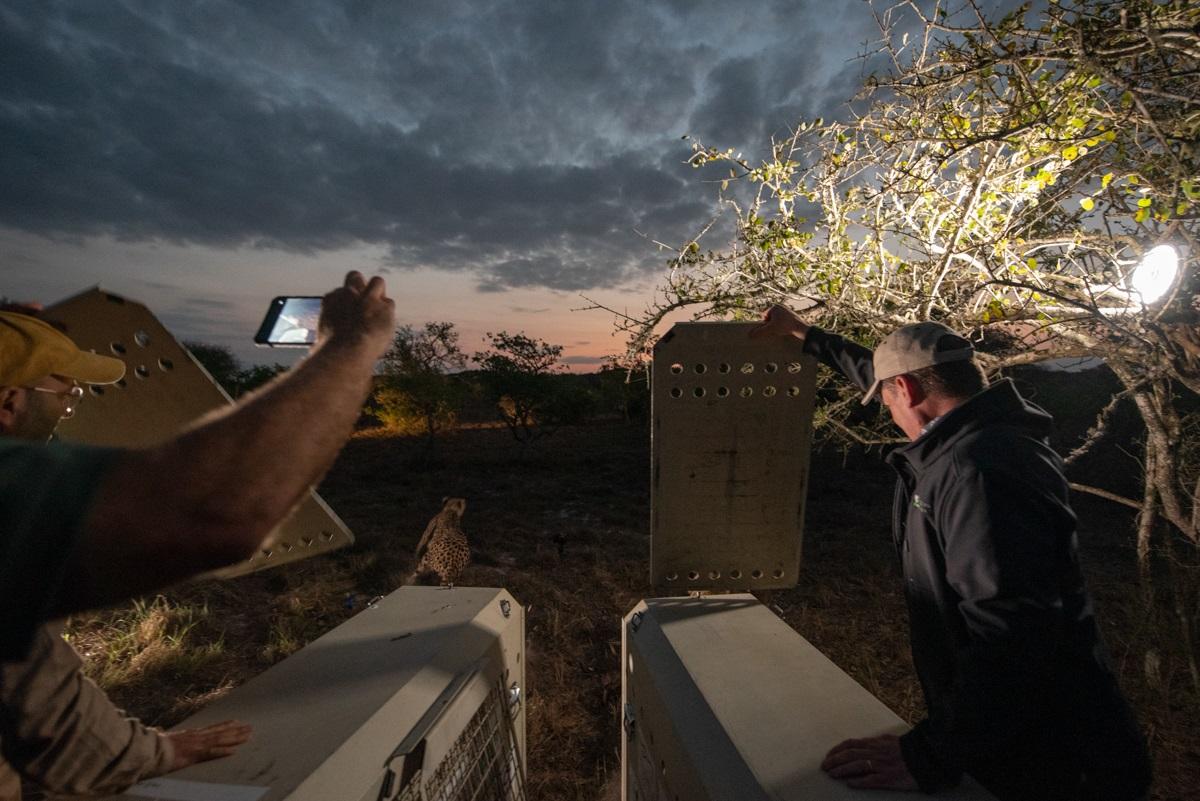Africa-Press – Mozambique. Cheetahs will soon grace the wildlife-rich plains of Maputo Special Reserve in southern Mozambique for the first time since the 1960s, as four of the threatened big cats – sourced from private game reserves in South Africa – have been transported safely to holding bomas within the reserve. They will undergo an acclimatisation period, before being released into the 104 200ha reserve, completing this reintroduction of the world’s fastest land mammal.
The reserve is managed through a partnership agreement signed between Mozambique’s National Administration for Conservation Areas (ANAC) and Peace Parks Foundation in 2018. With support from Ashia Cheetah Conservation, the Endangered Wildlife Trust (EWT) and veterinary partner the Mozambique Wildlife Alliance, drawing on decades of combined experience, the first four cheetahs will now be reintroduced.
ANAC Director-General Mateus Mutemba points out that:
“We have been committed to expanding and safeguarding the precious ecological assets of Maputo Special Reserve, a region that protects the best of Mozambique’s natural heritage. Through our partnership with Peace Parks, the reintroduction of cheetah is yet another historic conservation milestone in Mozambique and in the ongoing development of the reserve into a self-sustaining operation that generates revenue for the communities living in the area.”
Two male cheetahs were flown in from the andBeyond Phinda Private Game Reserve in KwaZulu-Natal, whilst an adult female and her sub-adult female cub were flown from the Waterval Private Game Reserve (of which Botlierskop Game Reserves & Villas are custodians) near Kimberley in the Northern Cape. The cheetahs were donated by Ashia, which also covered the costs of the translocation, including transportation, vaccination and the fitting of tracking collars to monitor the big cats in their new environment.
The reintroduction of the cats into Maputo Special Reserve is part of an ambitious goal to establish a healthy metapopulation (a group of spatially separated populations of the same species which interact at some level) that contributes to the conservation of the cheetah (Acinonyx jubatus), a species which has been eliminated from 90% of its range in Africa, with an estimated population of only 6 600 individuals remaining.
“Reintroduction of cheetahs into protected areas is one of the key strategies to reduce the risk of extinction, fuelled by habitat loss and events such as persecution, prey depletion and disease,” explains Marna Smit, Director for Ashia Cheetah Conservation.
“We therefore welcomed the opportunity to partner with ANAC and Peace Parks, as well as the Cheetah Range Expansion Project of the EWT, to introduce cheetah into the suitable habitat of Maputo Special Reserve.”
The rewilding programme is a vital component of the restoration and development of the reserve and, largely through funding support from the World Bank Mozbio Programme, almost 5 000 animals, including, buffalo, giraffe, impala, kudu, nyala, waterbuck, warthog, oribi, eland, blue wildebeest and zebra have been translocated here over the past decade. Total animal numbers are estimated at between 15 000 and 17 000 today, indicating the health of the natural ecosystems in the reserve and success in intensified management and protection activities. Under the partnership agreement, Peace Parks Foundation and ANAC have been jointly developing the reserve and the adjoining Ponta do Ouro Partial Marine Reserve, which protect a spectacular mosaic of inland, coastal and marine components. This is one of the few places in Africa where you can see elephants and whales on the same day.
With plenty of prey and appropriate habitat in Maputo Special Reserve, the introduction of cheetah, which were extirpated from the region decades ago, was found to be suitable following a feasibility study from the EWT, which also managed the selection and relocation of the animals to Mozambique. This operation falls under the EWT’s Cheetah Range Expansion Project.
“This represents our 26th Cheetah reintroduction over the past decade. Thanks to the efforts of ANAC and Peace Parks, there are now greater levels of ecological functionality in the protected areas of Mozambique. This has created safe spaces for the reintroduction of wild cheetahs within their historical range,” says Vincent van der Merwe, Cheetah Range Expansion Project Coordinator at the EWT’s Carnivore Conservation Programme.
The reintroductions under the Cheetah Range Expansion Project have doubled the cheetah metapopulation from 217 animals in 48 protected areas to 478 cheetahs in 67 protected areas across South Africa, Mozambique, Zambia and Malawi. The metapopulation in this network of protected areas constitutes the only growing wild cheetah population worldwide.
Bringing back predators to restore ecosystems
Followed by the reintroduction of plains game, the translocation of predators to restored wilderness areas is a major new focus area for Peace Parks’ rewilding programmes in transfrontier conservation areas.
As Peace Parks CEO Werner Myburgh explains: “With the support of our partners, we are delighted to be playing a part in expanding the range of cheetahs, as part of our overall work in stabilising ecosystems and reintroducing carnivores to ecologically-restored landscapes. Not only is the rewilding programme in Maputo Special Reserve contributing to the reserve becoming a world-class wildlife and tourism destination, but restored ecosystems such as these are also critical carbon sinks to help contribute to mitigating climate change.”
Lying within one of the world’s 36 most biologically diverse and threatened ecosystems, the reserve is an essential component of the Lubombo Transfrontier Conservation and Resource Area, combining lakes, wetlands, swamp forests, grasslands and mangrove forests with a pristine coastline.
After three weeks in the bomas, the cheetahs will be released into the reserve, after which time they will be carefully monitored on a daily basis by the reserve management, in partnership with the University of Eduardo Mondlane and the EWT.
About National Administration of Conservation Areas (ANAC) of Mozambique
Founded in 2011, ANAC is an institution of the State responsible for the conservation of biodiversity and the sustainable development of ecotourism in Mozambique. Its main functions involve planning, coordination and implementation of activities in conservation areas, in partnership with other organizations and local communities. Conservation areas managed by ANAC occupy about 25% of Mozambique’s national territory, including seven Parks, seven National Reserves, and 70 sport hunting areas divided into 20 official hunting grounds, nine hunting blocks, and 13 community programs. www.anac.gov.mz
About Peace Parks Foundation
Founded in 1997, Peace Parks is a non-profit conservation organisation that facilitates the establishment and development of transfrontier conservation areas and provides co-management support to government conservation agencies for the restoration, protection and sustainable development of protected areas. In Mozambique, the Peace Parks portfolio include the Maputo Special Reserve and Ponta do Ouro Partial Marine Reserve as part of the Lubombo Transfrontier Conservation Area, and the Limpopo, Banhine and Zinave national parks as components of the Great Limpopo Transfrontier Conservation Area. www.peaceparks.org
About Ashia Cheetah Conservation
Ashia Cheetah Conservation is a non-profit conservation organisation founded to help prevent the further decline of wild cheetah populations. Genetic reinforcement through release, relocation, (re)introduction, as well as urgent, impromptu cheetah rescue operations take place in coordination with The Endangered Wildlife Trust (EWT) as well as local and international conservation authorities. To ensure longevity of this project and in partnerships with relevant scientific bodies, Ashia is initiating, funding and coordinating applicable research projects in order to contribute significantly to the conservation and genetic integrity as well as the growth and range expansion of the cheetah population in southern Africa. www.ashia.co.za
About Endangered Wildlife Trust
The Endangered Wildlife Trust (EWT) has worked tirelessly for nearly 50 years to save wildlife and habitats, with our vision being a world in which both humans and wildlife prosper in harmony with nature. From the smallest frog to the majestic rhino; from sweeping grasslands to arid drylands; from our shorelines to winding rivers: the EWT is working with you, to protect our world.
The EWT’s team of field-based specialists works across southern and East Africa, where committed conservation action is needed the most. Working with our partners, including businesses and governments, the EWT is at the forefront of conducting applied research, supporting community conservation and livelihoods, training and building capacity, addressing human wildlife conflict, monitoring threatened species and establishing safe spaces for wildlife range expansion. A beacon of hope for Africa’s wildlife, landscapes and communities, the EWT is protecting forever, together. Find out more at www.ewt.org.za
About Mozambique Wildlife Alliance
The Mozambique Wildlife Alliance (MWA) was established as a registered non-for-profit Mozambican organization created in 2020. The MWA was developed specifically to provide critical support to the National Administration of Conservation Areas (ANAC) in range of urgent conservation issues that fall under the ANAC governmental mandate but due to operational, funding, and technical restrictions have not been addressed. www.mwa.co.mz






